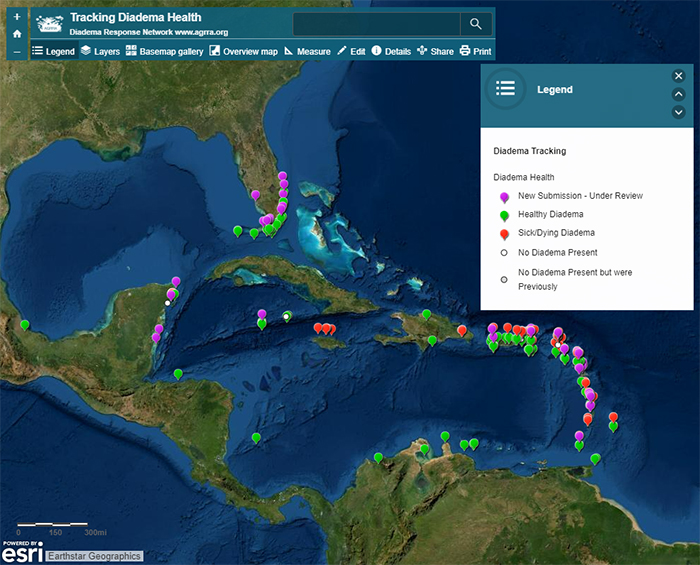- ABOUT US
- PROGRAM AREAS
- CONSERVATION APPROACH
- EDUCATION
- MULTIMEDIA
How Can the National Coral Reef Monitoring Program Help Understand Long-Spined Sea Urchin Die-Offs?
by Erica K. Towle, Ph.D., National Coral Reef Monitoring Program Coordinator
The Caribbean may be facing a widespread die-off of sea urchins. Diadema antillarum, also known as the long-spined sea urchin, is one of the most important herbivores on Caribbean coral reefs because they eat algae, reducing algal overgrowth on the seafloor, which in turn provides reef area for coral growth. Diadema antillarum previously experienced a massive die-off throughout the Caribbean in the 1980s. In February 2022, scientists learned of extensive Diadema antillarum die-offs in St. Thomas, U.S. Virgin Islands (USVI). Since February, additional mortality events have been observed in St. John and St. Croix (USVI), Puerto Rico, and other Caribbean islands. Scientists do not know what is causing these die-offs, and the speed at which large numbers of sick urchins are dying resembles the mortality event of the 1980s. NOAA and our partners are worried that a crisis is occurring in the Caribbean, where stony coral tissue loss disease has already caused widespread coral mortality beginning in 2014.

NOAA's National Coral Reef Monitoring Program (NCRMP) is a strategic framework for evaluating biological (fish, corals, and benthic communities), climatic, and socioeconomic indicators of coral health in U.S. coral reef areas. These data provide a robust picture of the status and trends of U.S. coral reefs and the human communities connected to them. NCRMP collects information on coral condition (including disease presence or absence), benthic cover, habitat composition, and reef complexity. In the Atlantic and Caribbean, NCRMP also collects information on key invertebrates like Diadema antillarum.

NCRMP will contribute to monitoring the current Diadema mortality event by adding a visual assessment of Diadema antillarum health condition to the current monitoring protocol. This work will occur along the Florida Reef Tract and Flower Garden Banks (Gulf of Mexico) during the 2022 field season. If divers observe Diadema antillarum, they will note whether individual urchins are healthy, diseased, or dead. NCRMP field surveyors will report disease observations immediately to partners and colleagues at the Atlantic and Gulf Rapid Reef Assessment, which has developed a Diadema Response Network to track Diadema health as well as coordinate information sharing, data collection, and research.
For more information about NCRMP, contact Erica Towle.
For more information or if you want to become involved in the Diadema Response Network, contact Diadema@agrra.org.
About Us

The NOAA Coral Reef Conservation Program was established in 2000 by the Coral Reef Conservation Act. Headquartered in Silver Spring, Maryland, the program is part of NOAA's Office for Coastal Management.

The Coral Reef Information System (CoRIS) is the program's information portal that provides access to NOAA coral reef data and products.
Work With US
U.S. Coral Reef Task Force
Funding Opportunities
Employment
Fellowship Program
Contracting Assistance
Graphic Identifier
Featured Stories Archive

Access the archive of featured stories here...
Feedback
Thank you for visiting NOAA’s Coral Reef Conservation Program online. Please take our website satisfaction survey. We welcome your ideas, comments, and feedback. Questions? Email coralreef@noaa.gov.
Stay Connected
Contact Us
NOAA’s Coral Reef Conservation Program
SSMC4, 10th Floor
1305 East West Highway
Silver Spring, MD 20910
coralreef@noaa.gov
